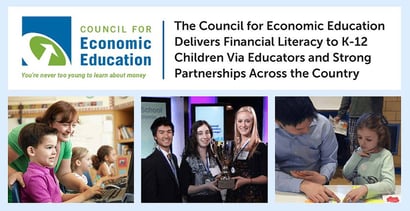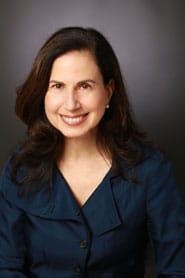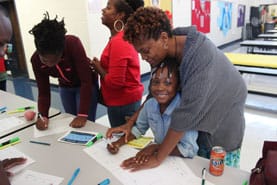

In a Nutshell: Conversations around financial literacy are lacking in households in the U.S. and in K-12 curriculums. The goal of the Council for Economic Education (CEE) is to deliver competent and modern financial education to every child. The organization strives to accomplish its mission by developing and delivering educational materials to teachers and educating them along the way. The CEE also hosts two annual competitions — the National Economics Challenge and the National Personal Finance Challenge. And it maintains an extensive partner network, most recently collaborating with Invest in Girls, a group that provides financial literacy programming for young women.
The fact that the United States is suffering from a serious lack of financial education is no big secret. I can say firsthand that I had zero financial literacy classes or workshops during my school days.

Nan Morrison is the CEO of the Council for Economic Education.
In fact, 2 out of 3 adults in the U.S. cannot pass a basic financial literacy test, according to a 2016 Financial Industry Regulatory Authority survey of more than 27,000 people. You can see how you stack up here.
The financial literacy problem is very real, and Nan Morrison, CEO of the Council for Economic Education (CEE), emphasized the importance of doing a better job to deliver quality financial education to America’s youth.
“Money should not be a scary subject,” she said. “Money should be something recognized as giving people access and choices. We should be getting children comfortable with the language and grammar of money when they’re very young.”
The CEE’s mission is to teach K-12 students about economics and personal finance so they can make better decisions in their lives — for themselves, their families, their communities, and the country, she said.
Educating the Educators: Meeting Teachers Where They are With What They Need
The CEE seeks to accomplish its mission primarily by providing curriculum tools, professional development, and a community of support to the educators who are working directly with K-12 children. Morrison said the CEE recently expanded its definition of educators to include not only school teachers but others who work with children, such as YMCA instructors.
“Our goal is always to meet the teachers where they are with what they need,” Morrison said. “That means meeting the 21st century needs of teachers. We’re making big investments in our online portal, EconEdLink, and providing more free resources for teachers.”
In addition to developing new lessons, the CEE continually evaluates existing educational materials to make sure they remain relevant in a fast-paced industry.

“We’re adding new topics as things change,” Morrison said. “People need to know more about cybersecurity as part of personal finance these days so we added elementary school lessons around that. My favorite one is ‘Goldilocks and the Three Passwords.’”
The CEE strives to make its programs and curriculum fun for teachers and students, she said, so the educators can easily integrate them into the classroom.
“In an ideal universe, the subject would be required the same way math or English is, but unfortunately that’s not the case,” Morrison said. “So, we also focus on how to bring about that change but it can be very different from state to state.”
She said the CEE builds relationships with policymakers and other influencers who can help increase financial literacy in schools. State treasurers are great spokespeople for personal finance and financial and economic literacy because they have a direct line to the people and can bring other powerful people together, she said.
The CEE also facilitates Family Financial Literacy Nights in schools with educators, principals, children, and parents.
“I had one parent say, “I had no idea my child was so interested and eager to learn about money. I was afraid to talk to him about it,’” Morrison said. “This is awesome. It’s opening up that dialogue and providing an opportunity for parents to learn this stuff as well and to be able to talk to their kids about it.”
The CEE Inspires Learning Through Two Major National Finance and Economics Competitions
Morrison said the CEE gets to work more directly with K-12 students through two competitions it hosts each year.
The National Economics Challenge — now in its 19th year — gives students the opportunity to compete in the areas of microeconomics, macroeconomics, international, and current events.
The competition is held at the state, national semi-final, and national final levels for high school students in two categories. The Adam Smith Division is for AP, international baccalaureate, and honors students. The David Ricardo Division is for general economic students.

CNBC journalist Steve Liesman hosts the National Economics Challenge.
Students who reach the national finals compete for cash prizes, trophies, and medals.
“The thing that’s so great about the National Economics Challenge is it’s not only teaching crucial skills to kids, but it provides an after-school activity that doesn’t require you to be an athlete or a mathlete, and it doesn’t require expensive equipment,” Morrison said.
The National Personal Finance Challenge is a more recent addition to the CEE’s lineup; it “provides middle and high school students with an exciting and motivating opportunity to build, apply, and showcase their knowledge” in personal finance.
The Challenge is also another opportunity for teachers to provide students with the tools and knowledge they need to help create financial stability and economic opportunity. State level winners advance to the national finals.
Morrison said 27 states participated in the National Personal Finance Challenge last year, and the organizers anticipate higher participation rates next year. The CEE hopes to have 25,000 students participate over the next three years, she said.
“Competition inspires students to learn. There’s data that shows that,” she said. “It’s a chance for these teams to come together and meet each other, learn from each other, and have an opportunity to present their thoughts to serious people in the field.”
Invest in Girls is the Latest in a Network of Strong Partnerships from the Local to National Level
“The CEE’s affiliate network is crucial to our success and sustainability,” Morrison said. “It keeps our fingers on the pulse of what’s happening in education all across the country.”
She said the CEE’s strong partner network, which allows it to distribute its resources to K-12 children, brings together great minds in education to help solve problems or develop new frameworks in its approach. Without its network, the CEE wouldn’t be able to facilitate its national competitions, Morrison said.

The CEE facilitates Family Financial Literacy Nights where parents and children learn about financial topics together.
“One new partnership I’m very excited about is with a wonderful program called Invest in Girls, which focuses on helping high school girls build financial capability,” Morrison said.
The program also provides access to knowledge and role models in the financial industry so girls can think more broadly about what their career options are, she said.
“As a woman who worked in financial services early in her career, getting more women in these fields is really important,” Morrison said. “If you don’t open the door and provide the opportunity to see what’s out there, these girls can really miss out. We’re excited to scale this program nationally.”
Morrison said other exciting endeavors for the CEE include continuing its digital transformation with and expanding the resources it provides to educators.
She said, ultimately it’s extremely important to deliver financial education at an early age.
“Just like anything else where we want to establish good habits like eating well or brushing your teeth, we want to set students on the right path for financial literacy at an early age,” Morrison said. “By the time they’re making their first financial decisions, they will have the language and basic tools they need for success.”
Advertiser Disclosure
BadCredit.org is a free online resource that offers valuable content and comparison services to users. To keep this resource 100% free for users, we receive advertising compensation from the financial products listed on this page. Along with key review factors, this compensation may impact how and where products appear on the page (including, for example, the order in which they appear). BadCredit.org does not include listings for all financial products.
Our Editorial Review Policy
Our site is committed to publishing independent, accurate content guided by strict editorial guidelines. Before articles and reviews are published on our site, they undergo a thorough review process performed by a team of independent editors and subject-matter experts to ensure the content’s accuracy, timeliness, and impartiality. Our editorial team is separate and independent of our site’s advertisers, and the opinions they express on our site are their own. To read more about our team members and their editorial backgrounds, please visit our site’s About page.
